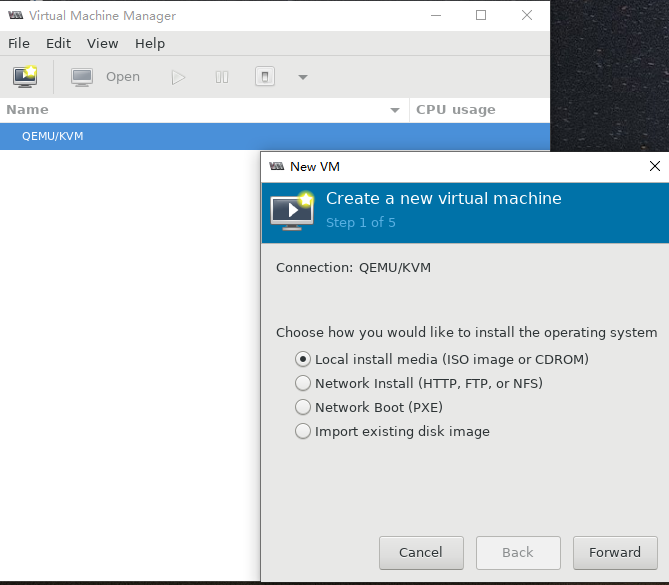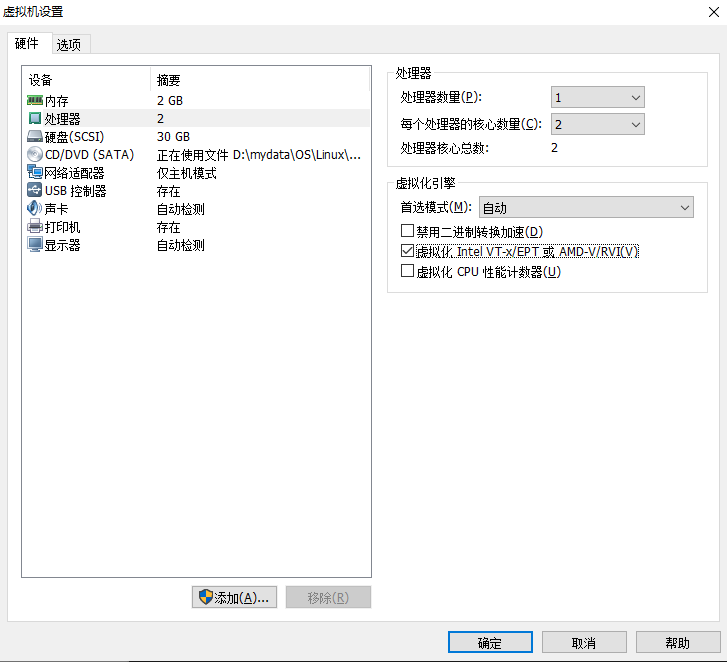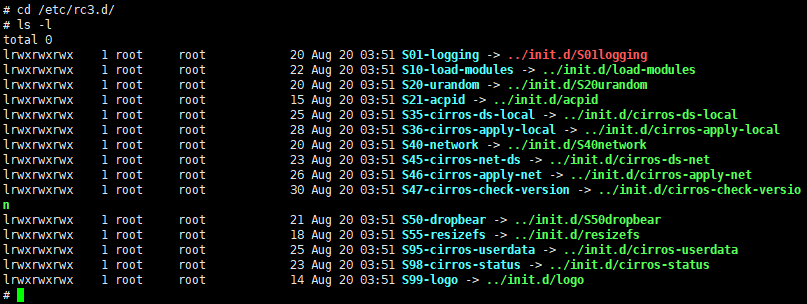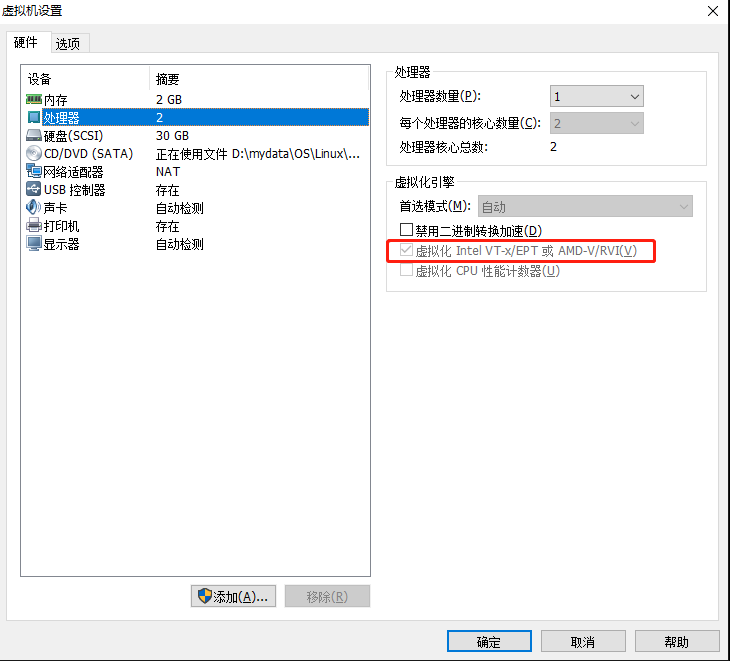一、libvirt安装配置
libvirt支持的虚拟化技术有:KVM, XEN, VMWARE, Qemu, LXC, OpenVZ;其node表示物理节点,domain表示虚拟机实例。
1.安装
libvirt相关组件
[root@master01 ~]# yum install libvirt libvirt-client virt-install virt-manager virt-viewer
安装qemu-kvm
[root@master01 ~]# yum install qemu-kvm
2.启动libvirtd
[root@master01 ~]# systemctl start libvirtd
3.配置
1. libvirt和libvirtd的配置文件:
- libvirt配置文件:/etc/libvirt/libvirt.conf
- 守护进程配置文件:/etc/libvirt/libvirtd.conf
2.qemu配置文件:/etc/libvirt/qemu/networks/default.xml
[root@master01 networks]# more /etc/libvirt/qemu/networks/default.xml <!-- WARNING: THIS IS AN AUTO-GENERATED FILE. CHANGES TO IT ARE LIKELY TO BE OVERWRITTEN AND LOST. Changes to this xml configuration should be made using: virsh net-edit default or other application using the libvirt API. --> <network> <name>default</name> <uuid>b6591a69-04c1-4f30-8866-9b966a1a6f28</uuid> <forward mode='nat'/> <bridge name='virbr0' stp='on' delay='0'/> <mac address='52:54:00:62:47:29'/> <ip address='192.168.122.1' netmask='255.255.255.0'> <dhcp> <range start='192.168.122.2' end='192.168.122.254'/> </dhcp> </ip> </network>

二、创建虚拟机
1.virt-manager
使用virt-manager调用图形化界面创建虚拟机
[root@master01 images]# virt-manager & [1] 3218

virsh命令使用说明:
[root@master01 images]# virsh --help virsh [options]... [<command_string>] virsh [options]... <command> [args...] options: -c | --connect=URI hypervisor connection URI -d | --debug=NUM debug level [0-4] -e | --escape <char> set escape sequence for console -h | --help this help -k | --keepalive-interval=NUM keepalive interval in seconds, 0 for disable -K | --keepalive-count=NUM number of possible missed keepalive messages -l | --log=FILE output logging to file -q | --quiet quiet mode -r | --readonly connect readonly -t | --timing print timing information -v short version -V long version --version[=TYPE] version, TYPE is short or long (default short) commands (non interactive mode): Domain Management (help keyword 'domain') attach-device attach device from an XML file attach-disk attach disk device attach-interface attach network interface autostart autostart a domain blkdeviotune Set or query a block device I/O tuning parameters. blkiotune Get or set blkio parameters blockcommit Start a block commit operation. blockcopy Start a block copy operation. blockjob Manage active block operations blockpull Populate a disk from its backing image. blockresize Resize block device of domain. change-media Change media of CD or floppy drive console connect to the guest console cpu-stats show domain cpu statistics create create a domain from an XML file define define (but don't start) a domain from an XML file desc show or set domain's description or title destroy destroy (stop) a domain detach-device detach device from an XML file detach-device-alias detach device from an alias detach-disk detach disk device detach-interface detach network interface domdisplay domain display connection URI domfsfreeze Freeze domain's mounted filesystems. domfsthaw Thaw domain's mounted filesystems. domfsinfo Get information of domain's mounted filesystems. domfstrim Invoke fstrim on domain's mounted filesystems. domhostname print the domain's hostname domid convert a domain name or UUID to domain id domif-setlink set link state of a virtual interface domiftune get/set parameters of a virtual interface domjobabort abort active domain job domjobinfo domain job information domname convert a domain id or UUID to domain name domrename rename a domain dompmsuspend suspend a domain gracefully using power management functions dompmwakeup wakeup a domain from pmsuspended state domuuid convert a domain name or id to domain UUID domxml-from-native Convert native config to domain XML domxml-to-native Convert domain XML to native config dump dump the core of a domain to a file for analysis dumpxml domain information in XML edit edit XML configuration for a domain event Domain Events inject-nmi Inject NMI to the guest iothreadinfo view domain IOThreads iothreadpin control domain IOThread affinity iothreadadd add an IOThread to the guest domain iothreaddel delete an IOThread from the guest domain send-key Send keycodes to the guest send-process-signal Send signals to processes lxc-enter-namespace LXC Guest Enter Namespace managedsave managed save of a domain state managedsave-remove Remove managed save of a domain managedsave-edit edit XML for a domain's managed save state file managedsave-dumpxml Domain information of managed save state file in XML managedsave-define redefine the XML for a domain's managed save state file memtune Get or set memory parameters perf Get or set perf event metadata show or set domain's custom XML metadata migrate migrate domain to another host migrate-setmaxdowntime set maximum tolerable downtime migrate-getmaxdowntime get maximum tolerable downtime migrate-compcache get/set compression cache size migrate-setspeed Set the maximum migration bandwidth migrate-getspeed Get the maximum migration bandwidth migrate-postcopy Switch running migration from pre-copy to post-copy numatune Get or set numa parameters qemu-attach QEMU Attach qemu-monitor-command QEMU Monitor Command qemu-monitor-event QEMU Monitor Events qemu-agent-command QEMU Guest Agent Command reboot reboot a domain reset reset a domain restore restore a domain from a saved state in a file resume resume a domain save save a domain state to a file save-image-define redefine the XML for a domain's saved state file save-image-dumpxml saved state domain information in XML save-image-edit edit XML for a domain's saved state file schedinfo show/set scheduler parameters screenshot take a screenshot of a current domain console and store it into a file set-lifecycle-action change lifecycle actions set-user-password set the user password inside the domain setmaxmem change maximum memory limit setmem change memory allocation setvcpus change number of virtual CPUs shutdown gracefully shutdown a domain start start a (previously defined) inactive domain suspend suspend a domain ttyconsole tty console undefine undefine a domain update-device update device from an XML file vcpucount domain vcpu counts vcpuinfo detailed domain vcpu information vcpupin control or query domain vcpu affinity emulatorpin control or query domain emulator affinity vncdisplay vnc display guestvcpus query or modify state of vcpu in the guest (via agent) setvcpu attach/detach vcpu or groups of threads domblkthreshold set the threshold for block-threshold event for a given block device or it's backing chain element Domain Monitoring (help keyword 'monitor') domblkerror Show errors on block devices domblkinfo domain block device size information domblklist list all domain blocks domblkstat get device block stats for a domain domcontrol domain control interface state domif-getlink get link state of a virtual interface domifaddr Get network interfaces' addresses for a running domain domiflist list all domain virtual interfaces domifstat get network interface stats for a domain dominfo domain information dommemstat get memory statistics for a domain domstate domain state domstats get statistics about one or multiple domains domtime domain time list list domains Host and Hypervisor (help keyword 'host') allocpages Manipulate pages pool size capabilities capabilities cpu-baseline compute baseline CPU cpu-compare compare host CPU with a CPU described by an XML file cpu-models CPU models domcapabilities domain capabilities freecell NUMA free memory freepages NUMA free pages hostname print the hypervisor hostname hypervisor-cpu-baseline compute baseline CPU usable by a specific hypervisor hypervisor-cpu-compare compare a CPU with the CPU created by a hypervisor on the host maxvcpus connection vcpu maximum node-memory-tune Get or set node memory parameters nodecpumap node cpu map nodecpustats Prints cpu stats of the node. nodeinfo node information nodememstats Prints memory stats of the node. nodesuspend suspend the host node for a given time duration sysinfo print the hypervisor sysinfo uri print the hypervisor canonical URI version show version Interface (help keyword 'interface') iface-begin create a snapshot of current interfaces settings, which can be later committed (iface-commit) or restored (iface-rollback) iface-bridge create a bridge device and attach an existing network device to it iface-commit commit changes made since iface-begin and free restore point iface-define define an inactive persistent physical host interface or modify an existing persistent one from an XML file iface-destroy destroy a physical host interface (disable it / "if-down") iface-dumpxml interface information in XML iface-edit edit XML configuration for a physical host interface iface-list list physical host interfaces iface-mac convert an interface name to interface MAC address iface-name convert an interface MAC address to interface name iface-rollback rollback to previous saved configuration created via iface-begin iface-start start a physical host interface (enable it / "if-up") iface-unbridge undefine a bridge device after detaching its slave device iface-undefine undefine a physical host interface (remove it from configuration) Network Filter (help keyword 'filter') nwfilter-define define or update a network filter from an XML file nwfilter-dumpxml network filter information in XML nwfilter-edit edit XML configuration for a network filter nwfilter-list list network filters nwfilter-undefine undefine a network filter nwfilter-binding-create create a network filter binding from an XML file nwfilter-binding-delete delete a network filter binding nwfilter-binding-dumpxml network filter information in XML nwfilter-binding-list list network filter bindings Networking (help keyword 'network') net-autostart autostart a network net-create create a network from an XML file net-define define an inactive persistent virtual network or modify an existing persistent one from an XML file net-destroy destroy (stop) a network net-dhcp-leases print lease info for a given network net-dumpxml network information in XML net-edit edit XML configuration for a network net-event Network Events net-info network information net-list list networks net-name convert a network UUID to network name net-start start a (previously defined) inactive network net-undefine undefine a persistent network net-update update parts of an existing network's configuration net-uuid convert a network name to network UUID Node Device (help keyword 'nodedev') nodedev-create create a device defined by an XML file on the node nodedev-destroy destroy (stop) a device on the node nodedev-detach detach node device from its device driver nodedev-dumpxml node device details in XML nodedev-list enumerate devices on this host nodedev-reattach reattach node device to its device driver nodedev-reset reset node device nodedev-event Node Device Events Secret (help keyword 'secret') secret-define define or modify a secret from an XML file secret-dumpxml secret attributes in XML secret-event Secret Events secret-get-value Output a secret value secret-list list secrets secret-set-value set a secret value secret-undefine undefine a secret Snapshot (help keyword 'snapshot') snapshot-create Create a snapshot from XML snapshot-create-as Create a snapshot from a set of args snapshot-current Get or set the current snapshot snapshot-delete Delete a domain snapshot snapshot-dumpxml Dump XML for a domain snapshot snapshot-edit edit XML for a snapshot snapshot-info snapshot information snapshot-list List snapshots for a domain snapshot-parent Get the name of the parent of a snapshot snapshot-revert Revert a domain to a snapshot Storage Pool (help keyword 'pool') find-storage-pool-sources-as find potential storage pool sources find-storage-pool-sources discover potential storage pool sources pool-autostart autostart a pool pool-build build a pool pool-create-as create a pool from a set of args pool-create create a pool from an XML file pool-define-as define a pool from a set of args pool-define define an inactive persistent storage pool or modify an existing persistent one from an XML file pool-delete delete a pool pool-destroy destroy (stop) a pool pool-dumpxml pool information in XML pool-edit edit XML configuration for a storage pool pool-info storage pool information pool-list list pools pool-name convert a pool UUID to pool name pool-refresh refresh a pool pool-start start a (previously defined) inactive pool pool-undefine undefine an inactive pool pool-uuid convert a pool name to pool UUID pool-event Storage Pool Events Storage Volume (help keyword 'volume') vol-clone clone a volume. vol-create-as create a volume from a set of args vol-create create a vol from an XML file vol-create-from create a vol, using another volume as input vol-delete delete a vol vol-download download volume contents to a file vol-dumpxml vol information in XML vol-info storage vol information vol-key returns the volume key for a given volume name or path vol-list list vols vol-name returns the volume name for a given volume key or path vol-path returns the volume path for a given volume name or key vol-pool returns the storage pool for a given volume key or path vol-resize resize a vol vol-upload upload file contents to a volume vol-wipe wipe a vol Virsh itself (help keyword 'virsh') cd change the current directory echo echo arguments exit quit this interactive terminal help print help pwd print the current directory quit quit this interactive terminal connect (re)connect to hypervisor (specify help <group> for details about the commands in the group) (specify help <command> for details about the command) [2]+ Done virt-manager
2.virt-install
virt-install是一个命令行工具,它能够为KVM、Xen或其他支持libvirt API的hypervisor创建虚拟机并完成GuestOS安装。此外,它能够基于串行控制台、VNC或SDL支持或图形安装界面。安装过程可以使用本地的安装介质如CDROM,也可以通过网络方式如NFS、HTTP或FTP服务实现。对于通过网络安装的方式,virt-install可以自动加载必要的文件以启动安装过程而无需额外提供引导工具。当然,virt-install也支持PXE方式的安装过程,也能够直接使用现有的磁盘映像直接启动安装过程。
virt-install命令有许多选项,这些选项大致可以分为:
1.一般选项:指定虚拟机的名称、内存大小、VCPU个数及特性等;
- -n NAME, –name=NAME: 虚拟机名称,需全局统一;
- -r MEMORY, –ram=MEMORY: 虚拟机内存大小,单位MB;
- –vcpu=VCPUS[,maxvcpus=MAX][,sockets=#][,cores=#][,threads=#]: VCPU个数及相关配置;
- –cpu=CPU: CPU模式及特性,如coreduo等,可以使用qemu-kvm -cpu ?来获取支持的CPU模式;
2.安装方法:指定安装方法、GuestOS类型等
- -c CDROM, –cdrom=CDROM: 光盘安装介质;
- -l LOCATION, –location=LOCATION: 安装源URL,支持FTP、HTTP及NFS等,如ftp://172.16.0.1/pub或http://172.16.0.1/Centos-x86_64;
- –pxe: 基于PXE完成安装;
- –livecd: 把光盘当做LiveCD;
- –os-tpye=DISTRO_TYPE: 操作系统类型,如Linux、Windows或Unix等;
- -x EXTRA, –extra-args=EXTRA: 根据–location指定的方式安装GuestOS时,用于传递给内核的额外选项,例如指定kickstart文件的位置,–extra-args “ks=http://172.16.0.1/class.cfg”;
- –boot=BOOTOPTS: 指定安装过程完成后的配置选项,如指定引导设备次序、使用指定的而非安装的kernel、initrd来引导系统启动等。例如:–boot cdrom,hd,network: 指定引导次序;–boot kernel=KERNEL,initrd=INITRD,kernel_args=”console=/dev/tty50″: 指定启动系统的内核及initrd文件;
3.存储配置:指定存储类型、位置及属性等;
–disk=DISOPTS: 指定存储设备及其属性,格式为–disk /some/storage/path,optl-val1,opt2=val2等,常用的选项:
- device: 设备类型,如cdrom、disk或floppy等,默认为disk;
- bus: 磁盘总线类型,其值可以是ide, scsi, usb, virtio或xen;
- perms: 访问权限,如rw, ro或sh(共享的可读写),默认为rw;
- size: 新建磁盘映像文件大小,单位GB;
- cache: 缓存模型,其值有none, writethrouth(缓存读)及writeback(缓存读写);
- format:磁盘映像格式,如raw, qcow2, vmdk等;
- sparse: 磁盘映像使用稀疏格式,即不立即分配指定大小的空间;
–nodisk: 不适用本地磁盘,在LiveCD模式中常用;
4.网络配置:指定网络接口的网络类型及接口属性如MAC地址、驱动模式等;
-w NETWORK, –network=NETWORK,opt1=val1,opt2=val2: 将虚拟机接入宿主机的网络中,其中NETWORK可以为:
- bridge=BRIDGE: 连接至名为”BRIDGE”的桥设备;
- network=NAME: 连接至名为”NAME”的网段;
其他常用的选项还有:
- model: GuestOS中看到的网络设备型号,如e1000, rtl8139或virtio等;
- mac: 固定的MAC地址,省略此选项时将使用随机地址,但无论何种方式,对于KVM来说,其前三段必须是52:54:00;
–nonenetwork: 虚拟机不适用网络设备;
5.图形配置:定义虚拟机显示功能相关的配置,如VNC相关配置
–graphics TYPE,opt1=val1,opt2=val2: 指定图形显示相关的配置,此选项不会配置任何硬件(如显卡),而是仅指定虚拟机启动后对其访问的接口;
- TYPE: 指定显示类型,如vnc, sdl, spice或none等,默认为vnc;
- port: TPYE为VNC或spice时其监听的端口;
- listen: TPYE为VNC或spice时所舰艇的IP地址,默认为127.0.0.1,可以通过修改/etc/libvirt/qemu.conf定义新的默认值;
- password: TPYE为VNC或spice时,为远程访问监听的服务指定认证密码;
–noautoconsole: 禁止自动连接值虚拟机的控制台;
6.设备选项:指定文本控制台、声音设备、串行接口、并行接口、显示接口等;
–serial=CHAROPTS: 附加一个串行设备至当前虚拟机,根据设备类型的不同,可以使用不同的选项,格式为”–serial type,opt1=val1,opt2=val2,……”, 例如:
- –serial pty: 创建伪终端;
- –serial dev,path=HOSTPATH: 附加主机设备至此虚拟机;
- –video=VIDEO: 指定显卡设备类型,可用取值为:cirrus, vga, qxl或vmvga;
7.虚拟化平台:虚拟机化模型(hvm或paravirt)、模拟的CPU平台类型、模拟的主机类型、hypervisor类型(如kvm、xen或qemu等)以及当前虚拟机的UUID等;
- -v, –hvm: 当前物理机同时支持完全虚拟化和半虚拟化时,指定使用完全虚拟化;
- -p, paravirt: 指定使用半虚拟化;
- –virt-type: 使用的hypervisor,如kvm, qemu, xen等,所有可用值可通过 ‘virsh capabilities’ 命令获取;
8.其他:
- –autostart: 指定虚拟机是否在物理机启动后自动启动;
- –print-xml: 如果虚拟机不需要安装过程(–import, –boot),则显示生成的XML而不是创建此虚拟机,默认情况下,此选项仍会创建磁盘映像;
- –force: 禁止命令进入交互模式,如果需要回到yes或者no选项,则自动回答为yes;
- –dry-run: 执行创建虚拟机的整个过程,但不会真正创建虚拟机、改变主机上的设备配置信息及将其创建的需求通过通知给libvirt: -d, –debug: 显示debug信息;
尽管virt-install命令有类似如上所述的众多选项,但实际使用过程中,其必须提供的选项仅包括–name, –ram, –disk(也可以是–nodisks)及安装过程相关的选项。此外,有事还需要使用–connet=CONNET选项来指定连接至一个非默认的hypervisor。
3.virt-install使用实例
1.导入映像文件创建虚拟机:
[root@master01 images]# virt-install -n vm01 -r 512 --vcpus=2,maxvcpus=3 --disk /opt/cirros-0.5.1-x86_64-disk.img --network bridge=virbr0,model=virtio --import --serial=pty --console=pty --nographics [root@master01 images]# virt-install -n vm02 -r 512 --vcpus=2,maxvcpus=3 --disk /opt/cirros-0.5.1-x86_64-disk.img --import --serial=pty --console=pty --nographics
- 切换到宿主机:”^]”即:Ctrl+]
- 切换到虚拟机控制台:virsh console VM_ID
2.创建一个名为vm02的虚拟机,其hypervisor为KVM,内存大小为512MB,磁盘为8GB的映像文件/var/lib/libvirt/images/vm02.img,通过ubuntu-18.04.4-live-server-amd64.iso光盘镜像来引导启动安装过程:
virt-install \ --connect qemu:///system \ --virt-type kvm \ --name vm02 \ --ram 512 \ --vcpu 1 \ --disk path=/var/lib/libvirt/images/vm02.img,size=8 \ --graphics vnc \ --cdrom /opt/ubuntu-18.04.4-live-server-amd64.iso
4.常用操作命令
- virt-install: 创建虚拟机,并安装操作系统OS,也可以创建虚拟机并导入Image文件;
- 根据xml文件创建虚拟机:create->创建并启动;define->创建但不启动;
- 关闭虚拟机domain: destroy, shutdown, reboot
- 删除虚拟机:undefine
- 连接至控制台:console
- 列出所有domain: list
- 附加或删除disk: attach-disk, detach-disk
- 附加或拆除网卡:attach-interface, detach-interface
- 保存状态值磁盘文件或从磁盘文件恢复:save, restore
- 暂停于内存或继续运行: suspend, resume
1.基于xml配置文件启动kvm虚拟机:
[root@master01 qemu]# virsh create /etc/libvirt/qemu/vm01.xml Domain vm01 created from /etc/libvirt/qemu/vm01.xml [root@master01 qemu]# virsh list Id Name State ---------------------------------------------------- 1 vm01 running
2.通过virt-viewer工具连接至虚拟机,后加虚拟机的ID号
[root@master01 qemu]# virt-viewer 1
3.关闭、删除虚拟机
[root@master01 opt]# virsh destroy vm04 # 关闭虚拟机vm04 Domain vm04 destroyed [root@master01 opt]# virsh undefine vm04 # 仅删除虚拟机配置文件vm04 Domain vm04 has been undefined [root@master01 opt]# virsh undefine vm04 --remove-all-storage # 删除虚拟机配置文件同时删除相关存储卷文件
4.动态添加、删除磁盘
[root@master01 opt]# qemu-img create -f qcow2 -o size=10G,preallocation=metadata /opt/second.qcow2 # 创建磁盘文件 Formatting '/opt/second.qcow2', fmt=qcow2 size=10737418240 encryption=off cluster_size=65536 preallocation='metadata' lazy_refcounts=off [root@master01 opt]# virsh attach-disk 3 /opt/second.qcow2 vda --targetbus virtio # 动态添加磁盘文件 Disk attached successfully [root@master01 opt]# virsh detach-disk 3 vda Disk detached successfully # 动态删除磁盘文件
5.动态添加、删除网络接口
[root@master01 opt]# virsh attach-interface 3 bridge virbr0 Interface attached successfully [root@master01 opt]# virsh detach-interface 3 bridge --mac MAC_ADDRESS # 根据mac地址删除
 琼杰笔记
琼杰笔记





评论前必须登录!
注册